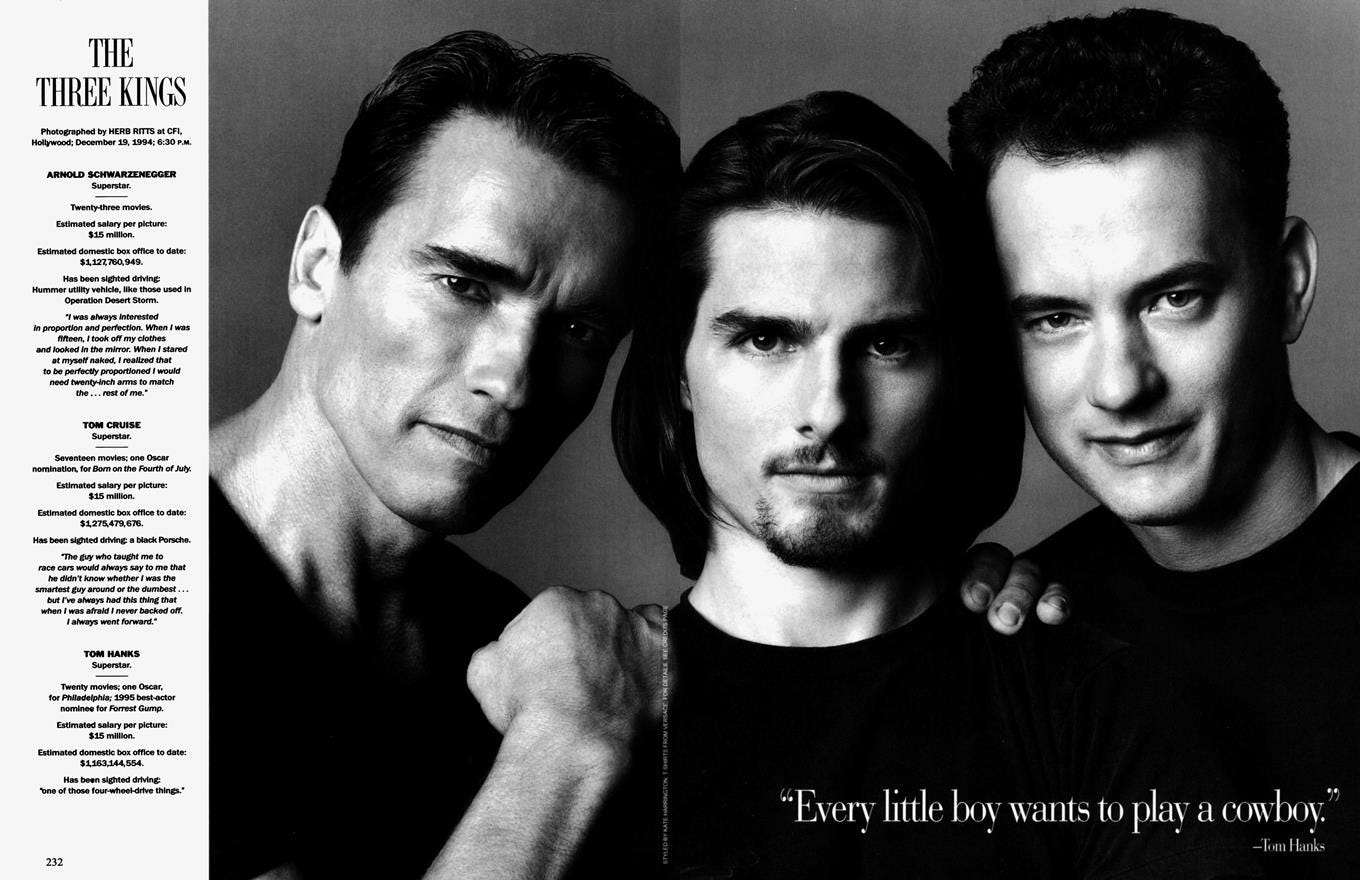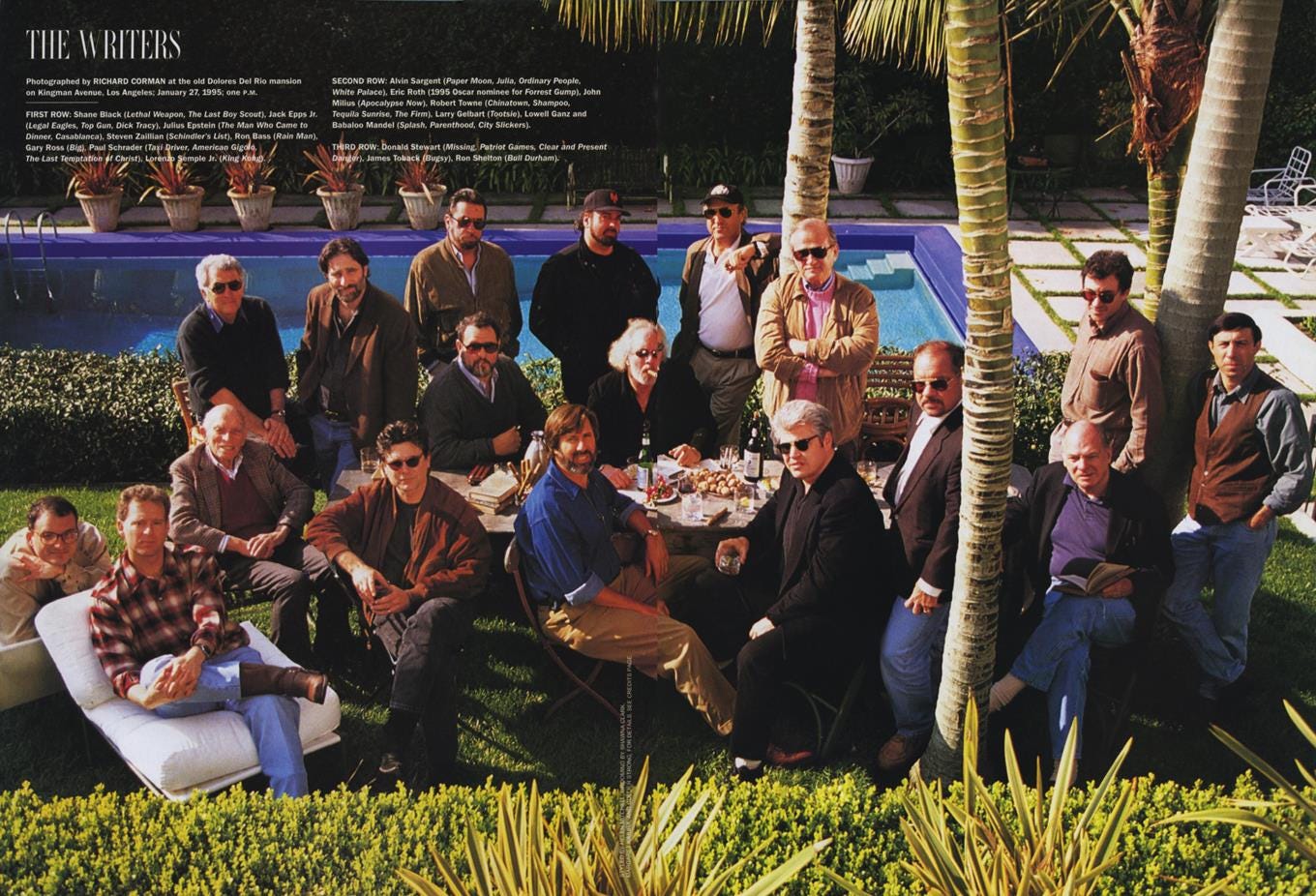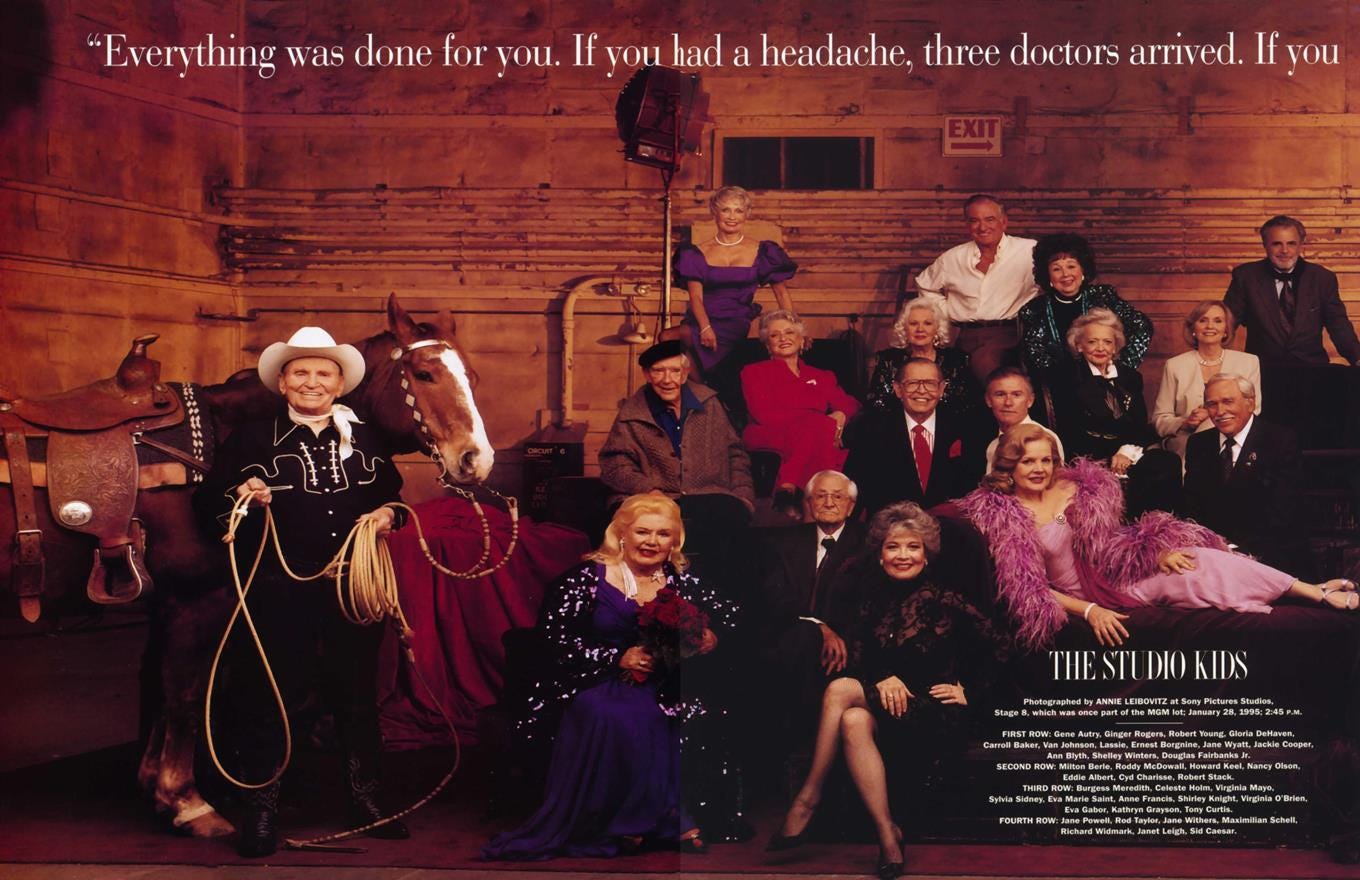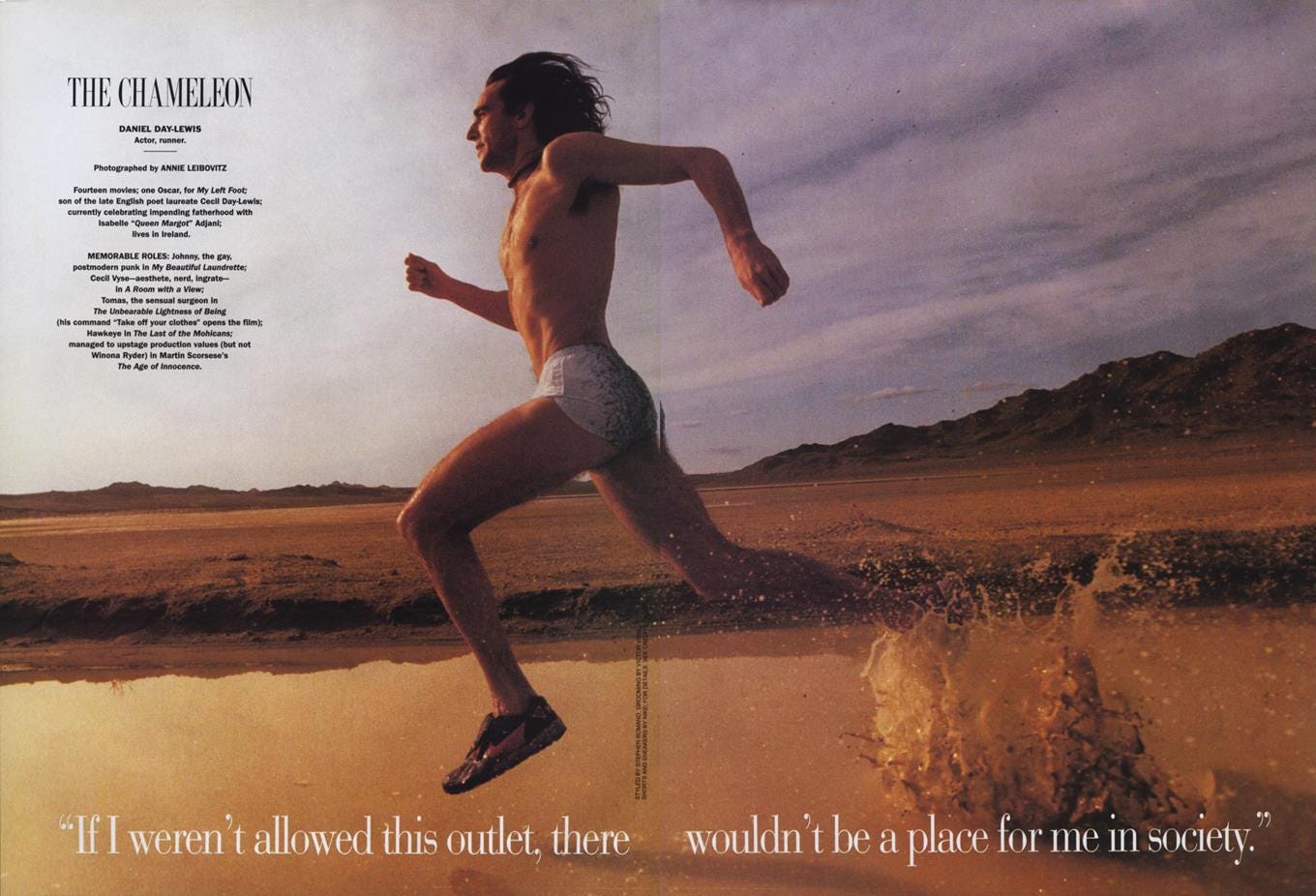Issue 24: The First Ever Vanity Fair Hollywood Issue
The origins of one of our favourite celebrity magazine traditions.
I’m not sure how it happened, but my piece on the Vanity Fair ingenues of 2003 photo became one of my most popular articles on this newsletter. It gave me yet another excuse to readthrough all of the old Hollywood issues and see whose hype paid off and who fell by the wayside.
Vanity Fair. "Hollywood: The Power & the Glamour." April 1995. A portfolio by Annie Leibovitz and Herb Ritts.
(Image via Vanity Fair.)
In 1995, cinema turned 100. The centenary of the first public film screening by the Lumiere brothers was the perfect opportunity for Hollywood to put some shine on its name. This was a big year for the industry. The theatrical box office of 1994 achieved record grosses, with nine films earning more than $100 million. 1994 also saw the 70th anniversary of Metro-Goldwyn-Mayer. Steven Spielberg won his first, long-awaited Oscar for Schindler's List. Turner Classic Movies premiered. With 1995, we’d see the premiere of the first-ever CGI-animated feature, Pixar’s groundbreaking mega-hit Toy Story. Big things were expected for the coming summer, with a new Batman in the form of Val Kilmer, Disney's much-hyped take on the story of Pocahontas, and Kevin Costner's guaranteed blockbuster hit Waterworld.
It was a good opportunity for celebration, and for Vanity Fair, the glossy magazine that sought to bring together glamour, power, and influence across various fields, they were the best platform for it. This was a chance to celebrate what editor Graydon Carter described as “for Americans […] the one true indigenous entertainment art.” That is a highly debatable assertion given that the Lumiere brothers were decidedly not from that side of the Atlantic. But certainly, Hollywood’s status as the defining force in the medium, at least commercially, was undeniable in 1995. Before the internet became more dominant a force in pop culture, before streaming or YouTube or the rise of Chinese blockbusters or AI, we had Hollywood, and nobody denied its power.
The year before this issue, Vanity Fair launched its first ever Oscars party, which is still considered one of the premiere after-events for the industry's biggest night. The Hollywood issue helped to cement the magazine's status as a major player in the '90s Oscar battles, a decade when wall-to-wall campaigning, dirty tactics, and year-round strategizing became the norm. No, Harvey Weinstein is not featured in this issue, although one could easily argue that his fingerprints are all over the piece with the inclusion of several Miramax faves.
The full magazine is dedicated to the power and the glamour of Hollywood and its adjacent realms. There’s a piece dedicated to mega-agent Michael Ovitz, some beautiful photographs of Golden Age legends by Cecil Beaton, a peek into the house of author Jackie Collins, and continuing coverage of the O.J. Simpson trial by Dominick Dunne. Christopher Hitchens hangs out with Billy Wilder for a piece. Before you even get to the main feature, you’re steeped in this world and the near-unfettered access that Vanity Fair can provide.
If you remember anything of the inaugural Hollywood issue, it’s probably its cover, which is, uh, of its time? It’s 1995 for worse, a weird mixture of Calvin Klein ad, awkward music video, and police line-up. Some actresses certainly fared better than others in this shoot. Poor Jennifer Jason Leigh is left posing like Gollum. Sarah Jessica Parker’s bra looks like it was added on in post, like the TV edit of Showgirls. Gwyneth’s in a ballgown for some reason and she sticks out like a sore thumb while all the other women are in sheer skirts and bras. It’s all very messy, clearly the building blocks for what would follow with this annual tradition. And hey, 1995 was a weird time. Skinny brows were coming back. We were all going through it.
To give the magazine credit, almost every single woman on the cover either became a megastar or has kept working to this day in some form. Eight of the ten are Oscar nominees. Five are winners. The outlier is Linda Fiorentino, who really should have been a star after The Last Seduction (she's also, for my money, the most beautifully shot on this cover.) It’s a starrier line-up than the ingenues of 2003. But even at the time, before many of these women reached the peak of their fame, this was a starry line-up. It's a pure display of power, one that the magazine is making a promise on. Oh, you think this is impressive? Read on.
They paid off that promise and then some. The first featured image is of "the three kings": Schwarzenegger, Cruise, and Hanks. Each had an estimated domestic box office gross of over $1 billion. Each pulled in $15 million per picture. Two were Oscar winners or nominees (hey, it could still happen, Arnie.) In the age of the Movie Star, how could you do better than that? Well, following it up with “the ingenue” Julia Roberts didn’t hurt. Then there's Robin Williams! Michael and Kirk Douglas! Harrison Ford! Denzel Washington! Michelle Pfeiffer! They’re all photographed individually, usually by Herb Ritts or Liebowitz, and they all look amazing.
(Image via Vanity Fair.)
But the real power plays here are the group shots. We get one of The Writers, including Shane Black, Paul Schrader, Eric Roth, John Milius, and Steven Zaillan. No women, though. Not in this shot of dudes with cigars by the pool, like they're an excerpt from The Kid Stays in the Picture. Weirdly, women fare better with The Directors, which includes Penny Marshall and Barbra Streisand alongside kings like Billy Wilder, Alan J. Pakula, and Barry Levinson. This is also a rare instance where one person is featured in two different sections, and of course it's Warren Beatty. He probably thought this issue was about him.
The range of settings and styles is so much fun. You’ve got Daniel Day-Lewis running in his underwear like he’s in a perfume ad (remember when The World’s Greatest Actor was primarily marketed as a total smoke show? I miss those days.) There’s an ensemble of Oscar-winning actresses dressed to the nines and walking together, including Liza, Whoopi, Marlee, Kathy, and Holly (and frankly, some of them have never looked so beautiful in print as this.) Tony Curtis and Jack Lemmon are together in their undies and make-up, a homage to Some Like It Hot. While many images are quite simple in their layout, others are a full production.
(Image via Vanity Fair.)
Every image comes with a slogan for its featured player. Robin Williams is “the wild card.” George Burns is “the trouper.” Clint Eastwood is, of course, “the gunslinger” (they also make sure to let us know that he’s a Ross Perot supporter. Okay?) Aside from actors and filmmakers, we also get to see the likes of Lew Wasserman, the former chairman and C.E.O. of MCA, a legendary talent broker who was once considered one of the most powerful men in the business. “If Hollywood is Mount Olympus, Lew Wasserman is Zeus,” said Jack Valenti in an accompanying quote. Later issues would include similar figures, from agents and costume designers to plastic surgeons. The theming would get more ambitious with some issues too, like the lavish noir edition that might be the greatest Hollywood Issue of all time. But there’s something about this grab-bag quality of people, styles, and humour that appeals to me. It’s maximalism, the anti-influencer aesthetic, if you will.
Perhaps the highlight of the issue is the four-page spread dedicated to the golden age studio stars. It’s a gorgeous and eye-wateringly rich ensemble full of some of the most beloved legends of the early days of Hollywood. It's got Ginger Rogers! Jackie Cooper! Eva Marie Saint! Jane Powell! Shelley Winters! Janet Leigh and Tony Curtis sitting FAR away from one another! It’s not just a display of star power but of history, and of a period that was close to extinction. I don’t know if all of these people are dead now (Eva Marie Saint is still with us) but I do know that you’d never be able to make another shoot like this happen. The Golden Age is over.
(Image via Vanity Fair.)
The lack of diversity is, of course, glaring. Vanity Fair would be plagued by this issue for years, acting as though they had no power to change it. Yes, the magazine is trying to reflect the entertainment industry of any given moment and that remains white, male, and American, but has anyone ever truly bought the idea that the power players of publishing, especially in the ‘90s, couldn’t help to shift the needle? We have Angela Bassett on the cover and Denzel and Whoopi Goldberg (looking GORGEOUS) in the mag, but imagine if the 1995 issue also had the likes of James Earl Jones (The Lion King was the biggest film of 1994), Alfre Woodard and Delroy Lindo from Crooklyn, Keanu Reeves (Speed is huge), John Lone (one of my favourite actors), and Samuel L. Jackson (it’s the Pulp Fiction year, kids!) There are always more options than you’re told there are.
It's also, predictably, America-centric. Well, yeah, it’s the Hollywood issue. Antonio Banderas and Sophia Loren are as European as it gets here, but both were becoming better known to Vanity Fair readers for their English-language work at this point in time (and for Antonio being Madonna’s biggest crush. She had taste.) This would change in future issues. Think of this year’s one, where the cover featured Lisa from BlackPink. Sure, she’s an actress now thanks to her work in The White Lotus, but her featuring in the Hollywood issue had more to do with her international fame as a singer and the ways in which Korean entertainment had become so popular to American audiences. This isn’t a knock against Lisa or the magazine for knowing who to feature. It’s just interesting to note how the changing nature of the mega-star in the current era has seen America fall behind.
And then there’s the jump scare at the end: Nancy Reagan. The hometown girl turned First Lady (shockingly, they don’t use her other nickname from her time as an actress. If you know, you know.) Vanity Fair was famously the magazine that put the Reagans on the cover in the middle of Ronnie’s time as President, selling them as a grand love story and the beating heart at the centre of the White House (just pay no attention to El Salvador, the demonization of Black women on welfare, or the entire AIDS epidemic.) Vanity Fair wasn’t an especially partisan publication, at least when it came to celebrity. They loved to hang out with power and money. It was their raison d’etre, after all. And from that story perspective, the former actress turned FLOTUS is a good sell. But it’s Nancy Reagan, guys. It was the Clinton era. I imagine introspective thinking on the ways that Reaganism just destroyed our planet weren’t at the forefront of people’s minds.
(Image via Vanity Fair.)
Everything about the Vanity Fair Hollywood Issue of 1995 is a reminder of a bygone era of publishing, a time when money was plentiful and there was no such thing as too big. In his new book, Graydon Carter talks about what it was like to be in this era of plenty and how an issue like this could come together through that combination of power and privilege. Magazines mattered. Stars wouldn’t say no to an appearance. They’d beg for the chance, and advertisers would throw blank cheques at Conde Nast to be featured alongside them. Visiting a piece like this in 2025, when AI is a real threat to my industry and staff jobs are as rare as hen’s teeth, was undeniably depressing. I lament how samey the Vanity Fair Hollywood issues have gotten now but what else could they be in this decade when print is dying and rising stars can just pose for Instagram and get better results? The brand still has a big role to play in matters like awards campaigning and general cultural reporting, but we’re all stuck in the same boat adrift in a sea of ChatGPT, layoffs, and dwindling wages.
These issues are also celebrations, proud showboating with no interest in deeper penetration. That’s how you get Nancy f*cking Reagan here without even an aside about the evils she endorsed. Could you imagine if they’d brought in a journalist to ask her about leaving Rock Hudson to die because she didn’t want to help out her old friend who was dying of AIDS? Even if the “good days” of publishing, sucking up to the talent was paramount.
Still, I love looking through these old issues and marvelling at such a full-throated commitment to elite style and prestige. It’s completely untouchable to the average reader and that’s why we love it. This is the most fantastical version of Hollywood, one where the biggest and brightest are living, looking, and acting like they inhabit another realm. Much in the same way that the Oscars are a barometer for how the American film industry wants the world to view it, the Hollywood Issue is a mirror of said image. In the ‘90s, a time of plenty, that meant grandeur, self-congratulations, nostalgia, and money. Now, it’s smaller but no less dedicated to creating a spectacle, and the spotlight has fallen upon those outside of that still-mighty bubble.
I’m not fetishistic of the past, as much as I would like to still live in a world where writers get $4 a word and there isn’t a giant plagiarism machine trying to steal all our work. As these issues reveal, the “good old days” were still a time of elitism and exclusion. The choice of who gets to be venerated in a magazine like this is a strong indicator of who is and isn’t respected, so seeing an all-male two-page spread of writers is revealing. Mercifully, we wouldn’t have that now but would it be one of gender and racial parity? I’m sceptical.
In an interview with The Hollywood Reporter, Carter said, “Only when you exit a golden age, do you realize that you were in one.” Maybe that’s why, in his final Hollywood Issue as editor-in-chief, he put himself on the cover alongside the actors.
(Hot. Image via Vanity Fair.)
Thanks for reading. You can find my work scattered across the internet. Over on Pajiba, I wrote about the horror of the contentification of the Sean Combs trial and the weirdness of the Beckham family feud. I wrote about the Mission: Impossible series and Ving Rhames’s role in it for RogerEbert.com. At Inverse, I celebrated the 40th anniversary of Terry Gilliam’s Brazil.
The last issue of the Gossip Reading Club did way better than I expected it to, so thanks so much to everyone who read it, signed up to the newsletter, and shared it with their friends. Hey, good word of mouth gets the job done. Who knew? Well, that and ragging on Jeff Bezos.










Entirely agree about Nancy Reagan. And yes, they should have asked her about Rock Hudson.
And the *male* stars should have been on the cover on their underwear.
This is so good. Thank you for sharing this.